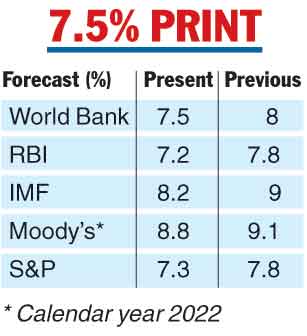The World Bank on Tuesday cut India’s economic growth forecast for the current fiscal to 7.5 per cent as rising inflation, supply chain disruptions and geopolitical tensions taper recovery.
This is the second time that the World Bank has revised its GDP growth forecast for India in the current fiscal 2022-23 . In April, it had trimmed the forecast from 8.7 per cent to 8 per cent and now it is projected at 7.5 per cent.

The GDP growth compares with 8.7 per cent growth in the previous fiscal.
“In India, growth is forecast to edge down to 7.5 per cent in the fiscal year 2022-23, with headwinds from rising inflation, supply chain disruptions, and geopolitical tensions offsetting buoyancy in the recovery of services consumption from the pandemic,” the World Bank said in its latest issue of the Global Economic Prospects.
Growth, it said, will also be supported by fixed investment undertaken by the private sector and by the government, which has introduced incentives and reforms to improve the business climate. This forecast reflects a 1.2 percentage point downward revision of growth from the January projection, the bank added.
“Growth is expected to slow further to 7.1 percent in 2023-24 back towards its longer-run potential,” it noted. A rise in prices across all items from fuel to vegetables and cooking oil pushed WPI or wholesale price-based inflation to a record high of 15.08 per cent in April and retail inflation to a near eight-year high of 7.79 per cent.
Price pain
High inflation prompted the RBI to hold an unscheduled meeting to raise the benchmark interest rate by 40 basis points to 4.40 per cent last month and another hike is expected on Wednesday.
Prior to the World Bank’s action, global rating agencies had also slashed India’s economic growth forecast.
Last month, Moody’s Investors Service trimmed the GDP projection to 8.8 per cent for the calendar year 2022 from 9.1 per cent earlier, citing high inflation.
S&P Global Ratings had cut its projection for 2022-23 to 7.3 per cent from 7.8 per cent earlier on rising inflation and longer than expected Russia-Ukraine conflict.
In March, Fitch had cut its forecast to 8.5 per cent from 10.3 per cent, while IMF has lowered the projection to 8.2 per cent from 9 per cent.
Asian Development Bank has growth at 7.5 per cent, while RBI in April cut the forecast to 7.2 per cent from 7.8 per cent amid volatile crude oil prices and supply chain disruptions due to the ongoing Russia-Ukraine war.
According to the World Bank report, growth in India slowed in the first half of 2022 as activity was disrupted both by a surge in Covid-19 cases accompanied by more-targeted mobility restrictions and by the war in Ukraine. The recovery is facing headwinds from rising inflation.
The unemployment rate has declined to levels seen prior to the pandemic, but the labour force participation rate remains below pre-pandemic levels and workers have shifted to lower-paying jobs.
In India, the focus of government spending has shifted toward infrastructure investment, labour regulations are being simplified, underperforming state-owned assets are being privatised, and the logistics sector is expected to be modernized and integrated, the bank said.











